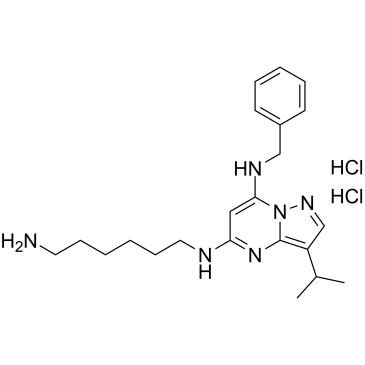BS 181 2HCl
Modify Date: 2025-08-27 00:10:12

BS 181 2HCl structure
|
Common Name | BS 181 2HCl | ||
|---|---|---|---|---|
| CAS Number | 1883548-83-1 | Molecular Weight | 453.45 | |
| Density | N/A | Boiling Point | N/A | |
| Molecular Formula | C22H34Cl2N6 | Melting Point | N/A | |
| MSDS | N/A | Flash Point | N/A | |
Use of BS 181 2HClBS-181 dihydrochloride is a potent and selective CDK7 inhibitor (IC50=21 nM) than Seliciclib (HY-30237). BS-181 is also against CDK2, CDK5 and CDK9 with IC50 values of 880 nM, 3000 nM and 4200 nM, respectively (fails to block CDK1, 4 and 6). BS-181 dihydrochloride inhibits a panel of cancer cells growth (IC50=11.5 μM-37.3 μM) and induces cell apoptosis. BS-181 dihydrochloride has the potential for the research of cancer therapy[1][2]. |
| Name | BS-181 dihydrochloride |
|---|
| Description | BS-181 dihydrochloride is a potent and selective CDK7 inhibitor (IC50=21 nM) than Seliciclib (HY-30237). BS-181 is also against CDK2, CDK5 and CDK9 with IC50 values of 880 nM, 3000 nM and 4200 nM, respectively (fails to block CDK1, 4 and 6). BS-181 dihydrochloride inhibits a panel of cancer cells growth (IC50=11.5 μM-37.3 μM) and induces cell apoptosis. BS-181 dihydrochloride has the potential for the research of cancer therapy[1][2]. |
|---|---|
| Related Catalog | |
| Target |
CDK7:21 nM (IC50) CDK2:880 nM (IC50) CDK5:3000 nM (IC50) CDK9:4200 nM (IC50) |
| In Vitro | BS-181 dihydrochloride (0-40 μM; 72 hours) inhibits cancer cells growth, it is against Breast cancer cell lines growth with IC50 values ranging from 15.1 μM to 20 μM, it is against Colorectal cancer cell lines growth with IC50 values ranging from 11.5 μM to15.3 μM and is against lung, osteosarcoma, prostate and liver cancer cell lines with IC50 values ranging from 11.5 μM to 37.3 μM, respectively[1]. BS-181 dihydrochloride (0-50 μM; 4 hours) shows inhibition of phosphorylation of the RNA polymerase II C-terminal domain (CTD) at serine 5 (P-Ser5). It down-regulates CDK4 and cyclin D1 expression while does not effect other CDKs and cyclins[1]. BS-181 dihydrochloride (0-50 μM; 24 hours) shows an increase in cells in G1, accompanied by a reduction in cell numbers in S and G2/M at low concentrations. At higher concentrations, however, cells accumulates in the sub-G1, indicative of apoptosis[1]. Cell Proliferation Assay[1] Cell Line: Breast cancer cell line: MCF-7, MDA-MB-231, T47D, ZR-75-1, etc Colorectal cancer cell line: COLO-205, HCT-116, HCT-116 (p53-/-) Lung cancer cell line: A549, NCI-460 Osteosarcoma cancer cell line: U2OS, SaOS2 Prostate cancer cell line: PC3, LNCaP Concentration: 0-40 μM Incubation Time: 72 hours Result: Had anti-proliferative activities against a panel of cell lines, including breast, lung, prostate and colorectal cancer. Western Blot Analysis[1] Cell Line: Breast cancer cell line: MCF-7 cells Concentration: 0 μM; 25 μM; 50 μM Incubation Time: 4 hours Result: Inhibited phosphorylation of CDK7 substrates. Apoptosis Analysis[1] Cell Line: Breast cancer cell line: MCF-7 cells Concentration: 0 μM; 25 μM; 50 μM Incubation Time: 24 hours Result: Led cells to G1 arrest and apoptosis. |
| In Vivo | BS-181 dihydrochloride (intraperitoneal injection; 10 mg/kg, 20 mg/kg; single dose) is well tolerated in mice without apparent weight altering[1]. BS-181 dihydrochloride (intraperitoneal injection; 5 mg/kg or 10 mg/kg twice daily; total daily doses of 10 mg/kg or 20 mg/kg; 14 days) inhibitstumor growth in a dose-dependent manner. Tumor growth exhibits 25% and 50% reduction compared with the control group, for 10 mg/kg/day and 20 mg/kg/day, respectively[1]. Animal Model: 7-week old female nu/nu-BALB/c athymic nude mice with MCF-7 cells[1] Dosage: 5 mg/kg or 10 mg/kg; 10 mg/kg or 20 mg/kg Administration: Intraperitoneal injection; twice daily or once total daily; 14 days Result: Inhibited tumor growth significantly. |
| References |
| Molecular Formula | C22H34Cl2N6 |
|---|---|
| Molecular Weight | 453.45 |